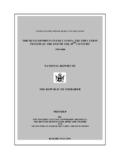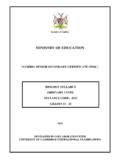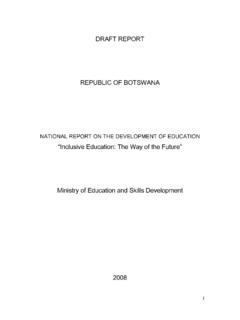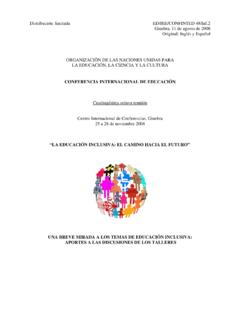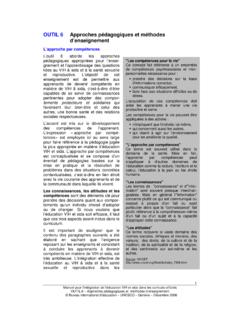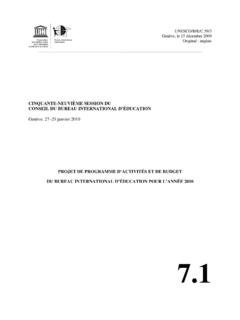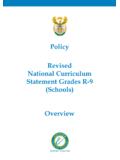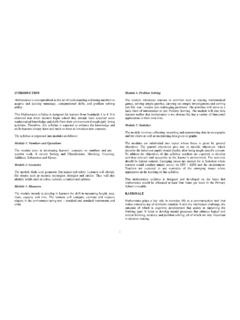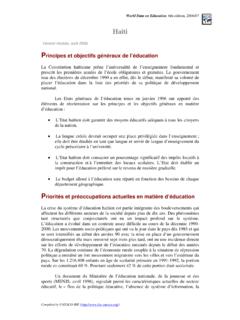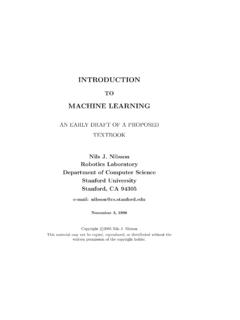Transcription of Improving student achievement in mathematics
1 INTERNATIONAL ACADEMY. EDUCATIONAL PRACTICES SERIES 4. OF EDUCATION. INTERNATIONAL BUREAU. OF EDUCATION. Improving student achievement in mathematics By Douglas A. Grouws and Kristin J. Cebulla The International Academy of Education The International Academy of Education (IAE) is a not-for-profit scientific association that promotes educational research,its dis- semination, and the implementation of its implications. Found- ed in 1986, the Academy is dedicated to strengthening the con- tributions of research, solving critical educational problems throughout the world, and providing better communication among policy makers, researchers and practitioners. The seat of the Academy is at the Royal Academy of Science, Literature and Arts in Brussels, Belgium, and its co-ordinating centre is at Curtin University of Technology in Perth, Australia.
2 The general aim of the IAE is to foster scholarly excellence in all fields of education. Towards this end, the Academy provides timely syntheses of research-based evidence of international im- portance. The Academy also provides critiques of research, its evidentiary basis, and its application to policy. The current members of the Board of Directors of the Acad- emy are: Erik De Corte, University of Leuven, Belgium (President);. Herbert Walberg, University of Illinois at Chicago, United States of America (Vice-President);. Barry Fraser, Curtin University of Technology, Australia (Ex- ecutive Director);. Jacques Hallak, UNESCO, Paris, France;. Michael Kirst, Stanford University, United States of America;. Ulrich Teichler, University of Kassel, Germany.
3 Margaret Wang, Temple University, United States of America. 2. Preface This booklet has been adapted for inclusion in the Educational Practices Series developed by the International Academy of Education (IAE) and distributed by the International Bureau of Education (IBE) and the Academy. As part of its mission, the Academy provides timely syntheses of research on educational top- ics of international importance. This booklet is the fourth in the series on educational practices that generally improve learning. The material was originally prepared for the Handbook of research on Improving student achievement , edited by Gordon Cawelti and published in a second edition in 1999 by the Educational Research Service (ERS). The Handbook, which also includes chapters on subjects such as generic practices and sci- ence, is available from ERS (2000 Clarendon Boulevard, Arlington, VA 22201-2908, United States of America; phone (1).)
4 800-791-9308;fax (1) 800-791-9309;and ). ERS is a not-for-profit research foundation serving the research and information needs of educational leaders and the public. Established in 1973, ERS is sponsored by seven organiza- tions: the American Association of School Administrators; the American Association of School Personnel Administrators; the Association of School Business Officials; the Council of Chief State School Officers; the National Association of Elementary School Principals; the National Association of Secondary School Principals; and the National School Public Relations Association. As Vice-President of the Academy and editor of the present series, I thank ERS officials for allowing the IAE and the IBE to make available the material adapted from the Handbook to edu- cators around the world.
5 The first author of the present pamphlet, Douglas A. Grouws,is Professor of mathematics Education at the University of Iowa. He was the editor of the Handbook of research on mathematics teaching and learning (Macmillan,1992) and has a large number of other publications on research in mathemat- ics education to his credit. He has made invited research pre- sentations in Australia, China, Hungary, Guam, India, Japan, Mexico,Thailand and the United Kingdom. He has directed sev- eral research projects for the National Science Foundation (NSF) and other agencies in the areas of mathematical problem- solving and classroom teaching practices. His current NSF work involves mathematics and technology. He received his from the University of Wisconsin. 3. The second author, Kristin J.
6 Cebulla, is a mathematics edu- cation doctoral student at the University of previously taught middle-school mathematics . Before teaching, she worked as a research chemical engineer. She received her bachelor of science degree in mathematics and chemical engineering from the University of Notre Dame and her master's degree from the University of Mississippi. The principles described in this booklet are derived in large part from the United States and other English-speaking coun- tries. Other research also has important implications for the teaching of mathematics . An example is Realistic mathematics Education, initiated by H. Freudenthal and developed since the early 1970s at the University of Utrecht (Dordrecht, The Netherlands, Kluwer, 1991). Another example is research on problem-solving summarized in a recent book by , B.
7 Greer, and E. De Corte Making sense of word problems (Lisse,The Netherlands, Swets & Zeitlinger, 2000). The officers of the International Academy of Education are aware that this booklet is based on research carried out primar- ily in economically advanced countries. The booklet, however, focuses on aspects of learning that appear to be universal in much formal schooling. The practices seem likely to be gener- ally applicable throughout the world. Even so, the principles should be assessed with reference to local conditions, and adapted accordingly. In any educational setting, suggestions or guidelines for practice require sensitive and sensible applica- tion and continuing evaluation. HERBERT Editor, IAE Educational Practices Series University of Illinois at Chicago 4.
8 Table of contents Introduction, page 7. 1. Opportunity to learn, page 10. 2. Focus on meaning, page 13. 3. Learning new concepts and skills while solving problems, page 15. 4. Opportunities for both invention and practice, page 17. 5. Openness to student solution methods and student interaction, page 19. 6. Small-group learning, page 21. 7. Whole-class discussion, page 23. 8. Number sense, page 25. 9. Concrete materials, page 27. 10. students ' use of calculators, page 29. Conclusions, page 31. Additional resources, page 35. References, page 39. This publication has been produced in 2000 by the International Academy of Education (IAE), Palais des Acad mies, 1, rue Ducale, 1000 Brussels, Belgium, and the International Bureau of Education (IBE), Box 199, 1211 Geneva 20, Switzerland.
9 It is available free of charge and may be freely reproduced and translated into other languages. Please send a copy of any publica- tion that reproduces this text in whole or in part to the IAE and the IBE. This publication is also available on the Internet in its printed form; see: or The authors are responsible for the choice and presentation of the facts contained in this publication and for the opinions expressed therein, which are not necessarily those of UNESCO/IBE and do not commit the Organization. The designations employed and the pre- sentation of the material in this publication do not imply the expres- sion of any opinion whatsoever on the part of UNESCO/IBE con- cerning the legal status of any country, territory, city or area, or of its authorities, or concerning the delimitation of its frontiers or boundaries.
10 Printed in Switzerland by PCL, Lausanne. 5. Introduction This booklet summarizes the mathematics chapter from the Handbook of research on Improving student achievement , second edition, published by the Educational Research Service. The Handbook is based on the idea that, in order to succeed, efforts to improve instruction must focus on the existing knowl- edge base in respect of effective teaching and learning. The Handbook was specifically designed to help school administra- tors and teachers carry out their evolving instructional leader- ship roles by giving them a ready source of authoritative yet practitioner-based information about research on effective teaching and learning. The practices identified in this booklet reflect a mixture of emerging strategies and practices in long-term use.
